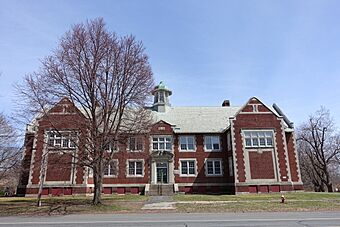Hatfield Center Historic District facts for kids
Quick facts for kids |
|
|
Hatfield Center Historic District
|
|

Center School
|
|
| Location | Roughly bounded by the Connecticut and Mill Rivers and Day Ave., Hatfield, Massachusetts |
|---|---|
| Area | 465 acres (188 ha) |
| Built | 1677 |
| Architectural style | Late 19th And 20th Century Revivals, Mid 19th Century Revival, Colonial |
| NRHP reference No. | 94000737 |
| Added to NRHP | July 27, 1994 |
The Hatfield Center Historic District is a special historical area in Hatfield, Massachusetts. It's like stepping back in time! This district shows how a colonial village looked long ago. It was first planned in 1661.
This historic area is found near the Connecticut River and the Mill River. It was added to the National Register of Historic Places in 1994. This means it's an important place to protect.
Exploring Hatfield's Historic Center
Hatfield's town center is set up in a long line. It runs north to south along Main Street. This street is close to the Connecticut River. The district also touches other historic areas nearby. These are the Elm Street and the Mill-Prospect Street Historic District.
Main Street has many homes built in the 1700s and 1800s. These houses are spread out nicely. This street is also the heart of the town. You can find the town hall, Center School, and Memorial Hall here.
A Village Designed for Safety
The way the houses were built was very clever. They were placed close to the street. This was part of a plan to protect the village. Long ago, during colonial times, the village was surrounded by a strong wooden fence. This fence was called a palisade. It helped protect the people from attacks.
Even though most buildings are newer now, you can still see this old plan. It shows how people thought about safety back then.
Old Buildings and Their Styles
The oldest buildings in the district were built around 1740. Two examples are at 30 School Street and 72 Main Street. These houses are in the Georgian style. This style was popular in the 1700s.
Georgian houses often have two and a half stories. They are made of wood and have sloped roofs. They usually have five windows across the front. Most houses in the district were built before 1830. They are either Georgian or Federal in style. The Federal style was popular after the Georgian period.
As the village grew, new houses were added. These houses showed different styles. Most of the town's important buildings, like the town hall, were built after 1870. However, the Congregational church is an exception. It was built in 1849 in the Greek Revival style. This style looks like ancient Greek temples.



